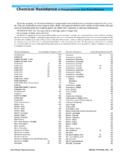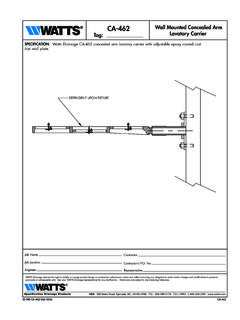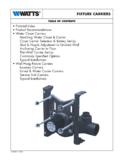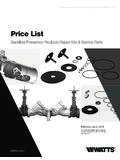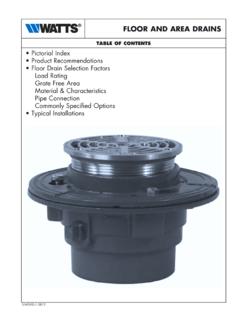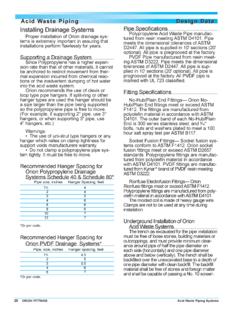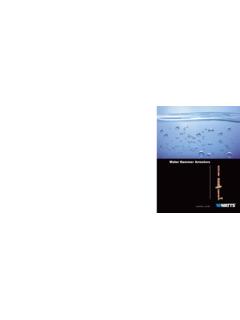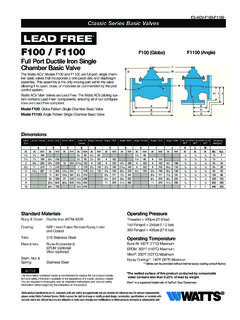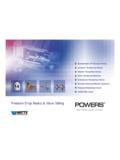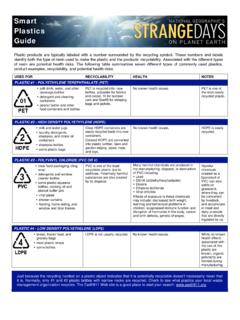Transcription of CHEMICAL - Watts
1 PH Monitoring Systems:In addition, Orion manufactures pH monitoring equipment that enables the owner to continuously measure and record the pH of thechemical waste discharge prior to it entering thesewer system. These monitoring systems areequipped with visual and audible alarms as well asdata acquisition recording devices that can be usedfor permanently recording pH discharge levels. CHEMICALTREATMENTSYSTEMS-OVERVIEW2 Index:pH, What does it mean? Page 3 CHEMICAL Discharge Guidelines Page 4 CHEMICAL Treatment Options Page 5-7 Tank Features & Properties Page 8 Dilution Tanks Page 9-13 Neutralization Tanks Page 14-17 Neutralization Tank Options Page 18-21 Neutralization Tank Extensions
2 Page 22 Decontamination Tank Page 23 Rectangular Tanks Page 24 Trap Doors Page 25pH Monitors Page 26-28 High/Low Level Alarms Page 29-30 Sinks Page 31-38 Terms & Conditions Page 39 Tanks(Waste, Neutralization, Dilution):Orion offers a wide range of CHEMICAL waste tanks, dilutiontraps, dilution tanks, solids interceptors and are designed to facilitate the dilution and neutralization of corrosive liquid waste, thereby renderingthe waste suitable for discharge into the sanitary sewersystem.
3 This protects the environment from contaminationand downstream piping systems from CHEMICAL :Orion s sinks are molded from durable virgin polyethylene. They are easy-to-install and are designed to provide years of tough service, even inintense CHEMICAL environments. Several models ofADA-compliant sinks are ( ) , WHATDOESITMEAN?3 The Importance of pH - Corrosion / Environmental ImpactpH is a measure of the hydrogen ion, (H+), concentration in a liquid and classifies liquids as beingacidic or caustic. Liquid discharges that are either too acidic or too caustic may cause corrosion damage to downstream piping systems and may also adversely affect the environment, or create problematicconditions for waste water treatment plants. It should be noted that acidic and caustic liquids can be equally harmful, hence they should betreated with equal effluent should be treated to ensure that the pH level is as close to 7 as possible, (or othervalues dictated by the local governing body).
4 PH ScalepH values range from 0 - 14 and indicate the degree of acidity or alkalinity of a liquid. A liquid witha pH value below 7 is acidic and a liquid with a pH value above 7 is alkaline. A pH of 7 indicatesthat a liquid is neutral. The pH scale is logarithmic rather than linear. This means that for eachchange in a whole number on the pH scale the hydrogen ion concentration varies by a factor of 10. For example:A liquid with a pH of 8 is 10 times more caustic than one with a pH of 7A liquid with a pH of 6 is 10 times more acidic than one with a pH of 7 Liquids with pH s of 8 and 6 both have hydrogen ion concentrations 1000 times that of pH 7 and have the same corrosive abilityA liquid with a pH of 5 is 100 times more acidic than one with a pH of 7pH values of common liquidsLiquidpHLiquidpHLiquidpHApple juice - Lemons - - - - - Lime - - - - CHEMICAL Waste Treatment ApplicationsLaboratories:Decontamination waste holding.
5 Commercial / industrialMiddle school Hospital decontamination areas CHEMICAL plantsHigh school Emergency ambulance stations Battery charging facilitiesUniversities CHEMICAL manufacturing plants Linen cleaning facilitiesMedical research Fire departments Photographic developingPharmaceutical Nuclear facilitiesPrinting shopsBiotechnologyPathology Forensic*Typical Application - Check LocalGoverning Authority for specific pHdischarge levels; where Waste Discharge GuidelinesGenerally effluent with a pH range of - can be disposed of without treatment, but local requirements may vary and must be adhered to. However, even mild caustics and acids within thisrange can cause severe damage to piping systems depending on the piping material.
6 It is recommended therefore that the compatibility of individual piping materials are checked for suitability against the predicted pH discharge level and the individual chemicals being discharged toensure compatibility. Many common products can cause severe damage over a period of time. Theitems listed on page 3 are some common liquids with varying pH levels, many of which would causepiping damage if not treated 2 Acidic FlowInTypical Dischargeto SewerpH *INLETVENTOUTLETLIMESTONE*pH *pH pHAcidic pHOUTLETVENTINLETCHEMICALWASTETREATMENTO VERVIEW5 NeutralizationNeutralization is a CHEMICAL reaction resulting from the physical mixing or extended contact of abase and an acid to form a neutral solution of water and salt. This neutral solution is suitable fordischarge into sanitary sewer systems. Orion accomplishes neutralization by utilizing one of threemethods: Chips, (calcium carbonate) Dosing*Typical Applications - Check Local Governing Authority for specific pH discharge levels; where Chip Neutralization In the Orion standard system acidic waste isdrained into an Orion tank filled with high purity limestone chips.
7 After a designed dwelltime in the tank of approximately 3 hours thechemical is neutralized and subsequently discharged by gravity flow into the sewer. Thechemical reaction creates an off-gassing andtherefore these tanks should be is the physical mixing of the chemicalwaste with water in order to stabilize the dilution can be as simple as flushing thechemical with water at the sink and dischargingthe mixture through a p-trap and the associateddrainage piping. Alternatively, dilution can be accomplished via a large dilution trap, or dilutiontank, located under the bench at each sink. In either case the waste piping should dischargeinto a central neutralization system for furthertreatment prior to discharge into the sewer Reaction Example With Hydrochloric Acid:CaCO2+ HCl = CaCl2+ CO2 The CO2 is off-gassed through the venting system6 CHEMICALWASTEOVERVIEWCONTINUEDM onitoring SystemsMany State and local authorities require that the pH level of CHEMICAL waste discharged into thesewer is monitored and quite frequently that the results are permanently recorded.
8 Orion achievesthese requirements through it s Neutraguard systems. The basic Neutraguard Monitor continuously monitors the pH level of the discharge and sounds analarm when an upset condition exists. In addition to pH monitoring, the Neutraguard Data Logging version digitally captures the pH level ofthe discharge. This data can be either locally or remotely accessed. Additional details on these systems are shown on page Dosing Systems Instead of using limestone chips for neutralization, chemicals can be injected into the waste streamto achieve the same result. Orion s Neutraguard Dosing System controls this process by introducinga solution of acid, or a solution of base, or both, into the CHEMICAL waste holding tank via meteringpumps, controls and mixers. The resulting liquid mixture chemically reacts to form a salt and watercomposition, which is then discharged by gravity flow into the sewer.
9 When CHEMICAL waste streams are known to be always caustic, only acid dosing is required. Similarly,when CHEMICAL waste streams are known to be always acidic, only caustic dosing is required. For systems that have unknown pH flows, the Neutraguard system will dose either acid or caustic systems are depicted or Caustic Dosing SystemCombined Acidand CausticDosing SystemNEUTRALIZATION ANDDILUTIONTANKS8 GeneralOrion tanks are manufactured by rotationally molding virgin resins to uniform wall thicknesses andare stress and defect free. Tank shells are held in stock and each tank is completed to individualcustomer specifications with respect to: Inlet, outlet, vent size, location and style; Tank lid type; Access port type, size and location; FRP (fiberglass re-inforced), wrap for direct burial or plain tank. A variety of tank configurations and styles are available, an overview of which is shown on page 9for dilution tanks and page 16 for neutralization Features Lightweight and easy to install Wide standard size range Custom sizes and configurations available Load bearing and non-load bearing tops available - plastic and plastic / metal combinations Direct buried tanks available with frp wrap Bolted, welded and combination tops available Manholes and easy access gamma ports available for inspection and limestone filling Fast delivery from factory Can handle most CHEMICAL waste requirements Minimum / easy maintenance High impact resistance High stress cracking resistance Cost effective Fiberglass reinforced (FRP)
10 , models availableMaterials of ConstructionPolyethyleneOrion tanks are manufactured as standard from high density polyethylene resin conforming toASTMD-1248. These are held in stock and can be used at temperatures up to 180 F in continuousservice or 212 F intermittently. Tanks are black in color as standard, but may also be supplied inopaque or white in larger sizes. Tank lids can be bolted or welded. Maintenance access ports can bepolyethylene threaded plugs, bolted manways, gamma cover with quick start thread, or a combinationthereof. All fittings and penetrations are polyethylene and are located according to the engineer sspecification. PolypropyleneCustom tanks can be manufactured from polypropylene resin conforming to ASTMD-4101. Thesetanks can be used at temperatures up to 212 F in continuous service and in areas of high chemicalconcentration.
